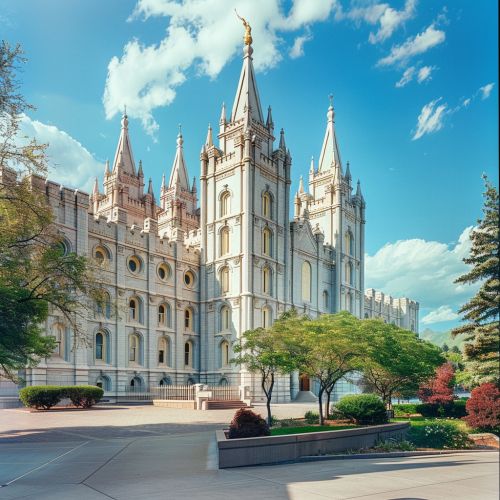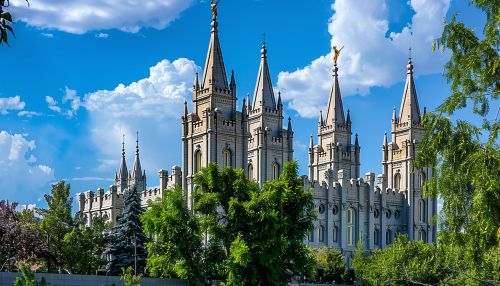Mormonism
Origins and History
Mormonism, also known as the Latter Day Saint movement, is a religious tradition that originated in the early 19th century in the United States. The movement was founded by Joseph Smith Jr. in the 1820s and 1830s. Smith claimed to have received divine revelations, which led to the publication of the Book of Mormon in 1830. This text is considered by adherents to be another testament of Jesus Christ, complementing the Bible.
Early Beginnings
Joseph Smith reported his first vision in 1820, in which he claimed to have seen God the Father and Jesus Christ. This vision is considered the foundational event of Mormonism. Smith's subsequent translation of the Book of Mormon, which he said was revealed to him by an angel named Moroni, marked the formal beginning of the movement. The book recounts the history of ancient American civilizations and their interactions with Jesus Christ.
Establishment of the Church
In April 1830, Joseph Smith and a small group of followers formally organized the Church of Christ, which would later become known as the Church of Jesus Christ of Latter-day Saints (LDS Church). The early years of the church were marked by rapid growth and significant persecution. The church's headquarters moved several times, from New York to Ohio, Missouri, and finally to Nauvoo, Illinois.
Migration to Utah
Following the assassination of Joseph Smith in 1844, leadership of the church passed to Brigham Young. Under Young's direction, the majority of church members migrated to the Salt Lake Valley in present-day Utah. This migration, known as the Mormon Trail, was a significant event in the history of the American West.


Beliefs and Practices
Mormonism encompasses a wide range of beliefs and practices, many of which are unique to the tradition. Central to Mormon theology is the belief in continuing revelation, the idea that God continues to reveal divine truths to prophets.
Scriptures
The LDS Church recognizes four primary texts as scripture: the Bible, the Book of Mormon, the Doctrine and Covenants, and the Pearl of Great Price. These texts are considered to be the word of God and are used in teaching and worship.
The Godhead
Mormonism teaches a distinct concept of the Godhead, which includes God the Father, Jesus Christ, and the Holy Ghost as three separate and distinct beings. This belief contrasts with the traditional Christian doctrine of the Trinity, which posits that the Father, Son, and Holy Spirit are three persons in one essence.
Plan of Salvation
A central tenet of Mormon theology is the Plan of Salvation, which outlines the purpose of life and the path to eternal life. This plan includes the pre-mortal existence, mortal life, and the afterlife. Key components include faith in Jesus Christ, repentance, baptism, receiving the Holy Ghost, and enduring to the end.
Temples and Temple Work
Temples play a crucial role in Mormon worship and practice. Unlike regular meetinghouses, temples are considered houses of the Lord where sacred ordinances are performed. These ordinances include baptism for the dead, endowments, and celestial marriage.
Organizational Structure
The LDS Church has a hierarchical structure with a clear chain of authority. The highest governing body is the First Presidency, followed by the Quorum of the Twelve Apostles.
Local Leadership
Local congregations, known as wards or branches, are led by bishops or branch presidents. These leaders are responsible for the spiritual and administrative needs of their congregations. Stake presidents oversee multiple wards within a geographic area.
General Authorities
General Authorities are high-ranking leaders who have church-wide responsibilities. These include members of the First Presidency, the Quorum of the Twelve Apostles, and other quorums and councils. They provide guidance and direction to the entire church.
Cultural Impact
Mormonism has had a significant impact on American culture and society. The migration to Utah and the establishment of Salt Lake City are notable historical events. Additionally, the church's emphasis on family, education, and community service has influenced many aspects of American life.
Education
The LDS Church places a strong emphasis on education. It operates several universities, including Brigham Young University (BYU), which has campuses in Utah, Idaho, and Hawaii. The church also supports a worldwide seminary and institute program for youth and young adults.
Media and Arts
Mormonism has also made contributions to media and the arts. The church produces a variety of media content, including films, music, and literature. The Tabernacle Choir at Temple Square is one of the most well-known musical groups associated with the church.
Controversies and Criticisms
Mormonism has faced various controversies and criticisms throughout its history. These include issues related to polygamy, race, and gender.
Polygamy
One of the most well-known controversies is the practice of polygamy, which was publicly announced by Joseph Smith in the 1840s. The practice was officially discontinued by the LDS Church in 1890, but it has continued to be a point of contention and misunderstanding.
Race and the Priesthood
Another significant issue has been the church's historical stance on race. Until 1978, black members were restricted from holding the priesthood. This policy was reversed by a revelation received by church leaders, but it remains a sensitive and often discussed topic.
Gender Roles
The role of women in the church has also been a subject of debate. While women hold significant responsibilities in the church, including leadership roles in auxiliary organizations, they are not ordained to the priesthood. This has led to discussions and movements advocating for greater gender equality within the church.
